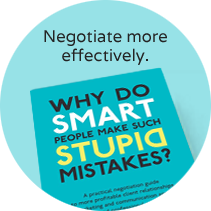Insights

Is your client a shoplifter?
Harry Hankinson is Britain’s most prolific shoplifter with 521 offences. But what has that got to do with my clients I hear you say? There is a parallel in business, more later. The definition of shoplifting is the taking of merchandise offered for sale without paying. For retailers it is a massive problem. It costs retailers around £12m a day. Researchers have found it is associated with opportunism and the perception that the shoplifter is unlikely to be caught.
Shoplifting has become more sophisticated and consequently so have the methods of detection used from CCTV to electronic tagging to security guards. Yet within business clients are commonly taking goods and services without paying through scope creep. Clients typically use the phrase “could you just….” And expect the extra value to be for free and included within the original price or fee. Scope creep costs businesses, especially service businesses, a fortune. Like a disease it will get worse unless treated. By allowing clients to scope creep you it simply sets a precedent and the client will continue.
Why does scope creep happen?
A common reason is the belief that it is of small cost and rather than rock the boat it is better to just absorb it. We say yes because we are afraid to say no or to put a price on the extra. During the recent recession scope creep has got worse for many companies. Finance Directors of some of my clients reckon it costs 10-20% off the bottom line. The danger is if we don’t put a price, and a therefore a value, on the extras then that is what we are saying, that it has no value.
Tolerating scope creep can suggest to clients that your prices are inflated and have so much fat built in that we can easily afford to absorb the cost.
In reality most businesses have seen a decline in profitability and many are on a financial knife edge. It also sends a message about your relationship with your clients. That you are in fear and in a transactional ‘buyer-supplier’ relationship dominated by price and cost,not a peer to peer trusted adviser relationship based on value and the impact we make on our clients’ business.
Should we charge for every little extra? A fine balance needs to be struck between commerciality and good service. My analogy is if I ask for another glass of water in a restaurant that should be free. If I ask for another glass of wine I should have to pay for it. Decide when it’s a glass of water or wine.
It is probably unrealistic to eradicate all scope creep. It is realistic to manage and reduce it considerably. You need to be subtle tackling scope creep with a long standing client used to getting their own way. Push back slowly.
Here are 7 tips to help you avoid being the victim of scope creep
- Identify where it is happening in your business and which clients are worst. Identify the three main areas. Work out what the cost is to the business.
- Plan how you will tackle it. Make sure your team are aware of the issue. Decide when is the best time to push back. Decide whether to take a slowly-slowly approach or whether to tackle it head on.
- Clients which are already unprofitable seem to be the worst for scope creep so you may want to consider parting company
- Develop a culture of being brave and assertive. Be on the front foot. This happens when we are winning more business.. For many businesses this year is likely to be a growth year and therefore a good one to sort this problem.
- Periodically review and measure the reduction in scope creep and improvement in profitability and morale.
- Sometimes we don’t tackle scope creep because we are so dependent on those major clients. Make sure no client is too big to walk away from.
- As scope creep has escalated so businesses need to be ever more aware.
‘Prevention is better than cure’. Take steps to pre-empt and prevent scope creep. The savings goes straight to your bottom line.
Published in WINNING EDGE
no comments
